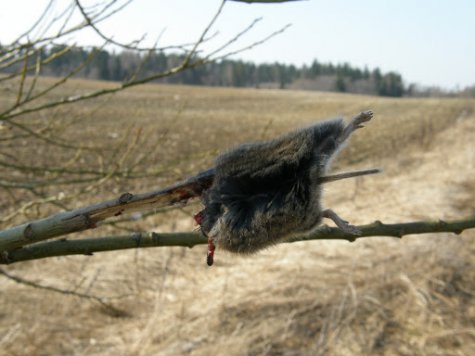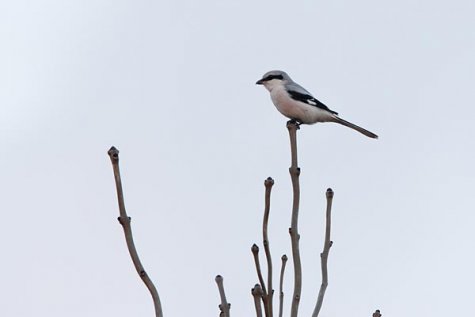Skewered mice
Photo from LK reader
Translation Liis
Somebody has skewered mice on the willow between the fields. Who does such things?
Photo Arne Ader
Grey shrike
Grey shrike Hallõgija Lanius excubitor
With its long tail and the plumage with strong contrasts the grey shrike reminds somewhat of a magpie, but it is only half as big and the size should make an observer attentive. The ”tit hawk”, as people used to call it earlier, belongs to the passerines: length including tail is about a quarter of a metre, weight only about 60-70 grams.
The bird observes the surroundings sitting upright in its lookout, usually quite visible. Its back and top of head are grey. Eye stripe, wings and tail are black. When it perches a white band shows, separating the grey of the back plumage and the black colour of the wings, where a white streak catches notice. The feathers at the edge of the black tail are also white.
The strong beak of the little bird looks quite hawkish – crooked at the tip. Grey shrikes have the same plumage throughout the year. The belly of the male is white, that of the female lightly striped, but this may often be unnoticed seen from a distance in poor autumn light.
The hunting tactics of the grey shrike are based on keeping watch, for which a solitary tree, shrub or fence post is suitable; at the top of it the bird patiently waits for a prey to appear – so grey shrikes are noticed by an experienced observer.
In case of a successful hunt the little robbers collect stores for themselves – sometimes we can find a half-eaten mouse between the branches of a shrub or even threaded on to a sprig: the signature of gray shrikes.
The number of grey shrikes breeding in Estonia is small, less than 500 pairs, and seeing them during the breeding period occurs very occasionally, most likely in some large bog massif.
In autumn and winter we probably see them more often, they often come to feeding places to hunt for passerines – people have not called them tit hawks in vain. They also hunt for small birds in reed banks, and for mice in open spaces.
A part of the grey shrikes that breed here move southwards in autumn, but in turn inhabitants from the North arrive here instead – what the proportions are not even specialists know but in winters nearly a thousand birds may be here to be seen, with luck.










